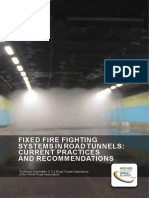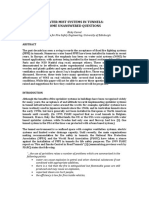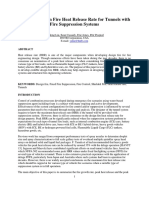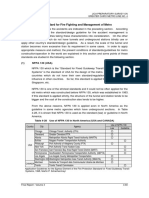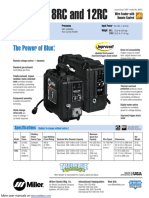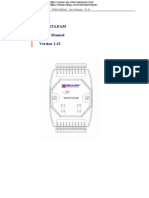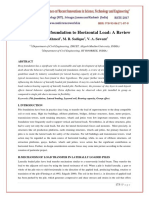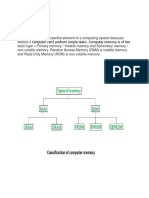Testing Water Mist Systems Against Large Fires in Tunnels
Testing Water Mist Systems Against Large Fires in Tunnels
Uploaded by
kdsessionsCopyright:
Available Formats
Testing Water Mist Systems Against Large Fires in Tunnels
Testing Water Mist Systems Against Large Fires in Tunnels
Uploaded by
kdsessionsCopyright
Available Formats
Share this document
Did you find this document useful?
Is this content inappropriate?
Copyright:
Available Formats
Testing Water Mist Systems Against Large Fires in Tunnels
Testing Water Mist Systems Against Large Fires in Tunnels
Uploaded by
kdsessionsCopyright:
Available Formats
SUPDET Extended Abstract
Mawhinney & Trelles, January 15, 2009.
TESTING WATER MIST SYSTEMS AGAINST LARGE FIRES IN TUNNELS: INTEGRATING TEST DATA WITH CFD SIMULATIONS.
J. R. Mawhinney, P.Eng., FSFPE; jmawhinney@haifire.com J. Trelles, Ph.D.; jtrelles@haifire.com Hughes Associates, Inc., #817 3610 Commerce Drive, Baltimore, MD 21227-1652
For presentation at the NFPA Suppression and Detection (SUP-DET) Technical Working Conference, Orlando, Florida, February 25-27, 2009. EXTENDED ABSTRACT As a result of a number of multiple-death fires that have occurred in the last few years in highway tunnels in Europe, for example the Mont Blanc and St. Gotthard tunnel fires, there is a growing demand on public highway officials to meet a minimum standard for life safety in tunnels [1, 2]. In addition, the huge economic losses (measured in billions of Euros) associated with the extended loss of use of a major transportation tunnel due to fire are of major concern to national governments. Although long viewed as unnecessary and even undesirable by tunnel authorities in Europe and North America [3, 4], active waterbased fire suppression systems now appear to be critically important to meeting life safety and property protection objectives of public highway authorities, as well as national security objectives. As a result of full-scale fire tests conducted in Runehamar in Norway in 2003 [5], the tunnel community has recognized that unsuppressed fires in tunnels can be much larger than previously thought. Water mist systems have been shown to be effective at mitigating the effects of even extremely large fires in tunnels. The finely atomized water mist maximizes the cooling efficiency of the spray at lower water flow rates than conventional sprinkler, deluge or water spray systems. Although other active suppression technologies have high potential, such as compressed air foam systems, water mist systems are presently the most cost effective technology accepted for active fire suppression systems in tunnels. In the last few years there have been a number of full-scale fire test programs to approve water mist systems for tunnels, including in Norway, the Netherlands, Germany, Austria, Switzerland, France and Spain. These tests have been supported by manufacturers of water mist system hardware, and witnessed by national approval agencies and transport authorities. The various tunnel authorities have independently developed the fire scenarios to be addressed, and the minimum level of performance to be deemed acceptable. Some tests involve hydrocarbon pool fires (Netherlands); some involve groups of passenger automobiles [6]; and others involve heavy goods vehicles (HGVs) loaded with normal cellulosic fuels or combined with plastics. As shown in the Runehamar test tunnel [5], normal HGV fuel loads (furniture) may generate fires ranging between 70 and 200 MW depending on plastic content. These fires are 10 to 30 times larger than, for example, the Factory Mutual water mist test protocols for machinery spaces for which the largest test fire is 6 MW [7]. Transportation authorities require that the test fires for evaluating the performance of water mist systems be in the same scale as the potential HGV fires, i.e., potentially 100 MW. Even the purchase of materials for such large fuel packages poses problems for achieving consistent and repeatable fire conditions. Tunnel safety authorities have developed performance criteria that must be met for a water mist system to obtain their approval. Based on experience with moderate scale fire testing traditionally used for approval testing, authorities typically select a temperature or other measurable condition that must be met at a specified point relative to the fire in a specified period of time. Interestingly, analysis of recent fire tests in tunnels suggests that single point measurements in the turbulent conditions associated with
SUPDET Extended Abstract
Mawhinney & Trelles, January 15, 2009.
large fires are not accurate or consistent measures of performance. As an example, a performance criterion was set such that the temperature at mid-height in the tunnel, at a distance of 5-m from the end of the fuel load, must be 350oC or less within 10 minutes of activation of the system. The evident assumption was that the temperature at that point should be initially high, and decrease with time as the suppression agent gradually reduced the intensity of the fire. However, because the fuel load was 14-m long and 3.5-m high, and the fire started at the upwind end, the unburned fuel shielded the downwind thermocouple so that it saw no heat for the first 15 minutes of the test. The hot gases flowed along the ceiling and did not descend to mid height of the tunnel until approximately 10-m from the end of the fuel load. The result was that temperatures at mid-height farther from the fire were higher than those closer to the fire, contrary to the logical expectations. Although the fire was controlled, it was not extinguished. When the fire burned to the end of the fuel load, heat was directed onto the critical thermocouple so that it suddenly became very hot 30 minutes into the test. The performance criteria, which had been selected based on the authoritys experience with smaller fires, did not reflect the actual performance of the water mist system. Several full scale fire test programs involving heavy goods vehicle (HGV) fires were conducted in the San Pedro de Anes Test Tunnel facility in Spain in 2006. Hughes Associates, Inc. acted as a third party witness and reporting agent for tests conducted by Marioff Corporation Oy of Finland [8]. The tests evaluated the performance of a Marioff Hi-Fog high pressure water mist system against fires in stacks of standardized wood Euro-pallets, intended to represent standard severity truck fires and in stacks of wood pallets interspersed with high density polyethylene (HDPE) plastic pallets, intended to represent high severity truck fires. The tests were instrumented to measure the heat release rate of the fires as well as temperatures at various positions in the tunnel. The tests confirmed the outstanding effectiveness of the water mist systems in controlling temperatures in the tunnel. Although the water mist system did not extinguish the fires, it reduced the Heat Release Rate (HRR) by 40 percent or more for even the most extreme fires. However, the degree of the reduction was not equal for all levels of fire severity. The finding suggests there is a need to differentiate between performance against standard severity fires involving normal cellulosic combustibles, and high severity" fires. It should not be required that the water mist system achieve the same temperature at a point at the same time for both levels of fire severity, but it is reasonable to expect that catastrophic damage to the tunnel be prevented even for the more severe fires. The San Pedro de Anes tests showed that very large fires (20 to 60 MW) create variable conditions, even for apparently similar test conditions. The complex interaction of the fire, proximity to the tunnel walls, ventilation air, water mist, and shadowing created by the fuel package and other obstructions to airflow resulted in fairly large variations in readings over small distances. There is a motivation to seek global performance criteria for evaluating suppression systems that are not fixed to single point parameters. In the San Pedro de Anes fire tests, HRR, temperature distributions, and tunnel ventilation air speeds were measured. There are many physical phenomena associated with fire suppression that were not measured, but which are indicators of the benefits of a suppression system. Computational fluid dynamics (CFD) modelling provides a means to visualize/understand the phenomena that cannot be easily observed or measured. Following the full-scale HGV testing conducted by Marioff, Hughes Associates, Inc. developed a CFD model of the test tunnel, and simulated the fire tests using the NIST Fire Dynamics Simulator FDS4 [9]. Data from the HGV fire tests were used to validate the simulations. The incentive for simulating the HGV fire tests was to provide a means of analyzing the performance of the water mist systems in terms of global performance criteria, and to permit one to explore a variety of
SUPDET Extended Abstract
Mawhinney & Trelles, January 15, 2009.
what if scenarios to determine how a water mist system might perform under different conditions. The simulation of an unsuppressed fire, which could not be conducted because it would have damaged the test tunnel, provided a point of comparison to illustrate the benefits of having a water mist system. The benefits of the suppression system can be characterized by parameters such as reduction in the surface area of ceiling exposed to damaging temperatures (compared to an unsuppressed fire), reduced region of high heat fluxes, elimination of back-layering and preventing propagation to targets. Furthermore, performance criteria should differentiate between standard versus high severity fuel packages, in recognition of the fact that the probabilities of occurrence of all fire scenarios are not equal, provided that catastrophic loss is prevented even in the worst case. Computational fluid dynamics (CFD) modeling is a powerful tool for extending the value of a limited number of fire test results, without incurring the cost of additional fire tests. If the CFD model can predict the degree of temperature management measured by the instrumentation in a real test, confidence in the accuracy of the model increases. This presentation will compare results of a CFD simulation using FDS4 with the measured results of full scale fire tests data and show how the model can be used to evaluate the performance of water mist systems in global terms. Examination of the simulation results reveals aspects of the conditions occurring in the tunnel that cannot be deciphered from the limited instrumentation results. It is possible to simulate configurations not tested and make comparisons that aid in understanding the benefits and limits of the suppression system. It is proposed that CFD modelling validated using fire test data, ought to become a requirement for performance evaluations of fire suppression systems. Keywords: computational fluid dynamics, fire testing, FDS, heavy goods vehicle, HGV fires, heat release rates, HRR, performance criteria, tunnels, water mist. REFERENCES 1. 2. 3. 4. 5. 6. Beard, A.N., and Carvel, R.O., (Eds.), The Handbook of Tunnel Fire Safety, Thomas Telford Publishing, London, U.K, 2005. Arvidson, M., Fixed Fire Suppression Concept for Highway Tunnels, International Conference on Tunnel Fires and Escape from Tunnels, Lyon, 5-7 May, 1999. NFPA 502, Standard for Road Tunnels, Bridges, and Other Limited Access Highways, 2004, National Fire Protection Association, Quincy, MA, U.S.A. World Road Association. Fire and Smoke Control in Road Tunnels, PIARC Committee on Road Tunnels, (C5), 1999. Ingason, H., & Lnnermark, A., Heat Release Rates from Heavy Goods Vehicle Trailer Fires in Tunnels, Fire Safety Journal, 40, No. 7, pp. 648-668, 2005. Mawhinney, J. R., Approval Testing of a Hi-Fog Water Mist System for Protection of a Passenger Vehicle Tunnel, Paris, France, Client Report HAI-5022-010-1, for Marioff Oy, Finland, October 7, 2005. FM Approvals, Approval Standard for Water Mist Systems, Class Number 5560, Appendix G, Fire Tests for the Protection of Machinery Spaces and Special Hazard Machinery Spaces with volumes 3 3 Exceeding 9,175 ft (260 m ), FM Global, Norwood, MA, May 2005. Mawhinney, J. R., and Ingason, H. Full-Scale Fire Testing of Suppressed Heavy Goods Vehicle Fires in Road Tunnels, Client Report HAI 5022-010-2 for Marioff Oy, Finland, San Pedro de Anes Test Tunnel, Asturias, Spain, February, 2006. Mawhinney, J. R., and Trelles, J., The Use of CFD-FDS Modeling for Establishing Performance rd Criteria for Water Mist Systems in Very Large Fires in Tunnels , in Proceedings of ISTSS 2008, 3 International Symposium on Tunnel Safety and Security, .Stockholm, Sweden, March 12 14, 2008.
7.
8.
9.
You might also like
- European Standard Norme Européenne Europäische NormDocument11 pagesEuropean Standard Norme Européenne Europäische NormRelu Garban100% (1)
- Cross PassagewaysVsStairs EdenbaumDocument10 pagesCross PassagewaysVsStairs EdenbaumtangouzeNo ratings yet
- Standard - UPTUN WP2 D251 Water-Based Fire Safety SystemsDocument39 pagesStandard - UPTUN WP2 D251 Water-Based Fire Safety SystemsmukeshsinghtomarNo ratings yet
- 02 MSS Final ElectricalDocument31 pages02 MSS Final ElectricalNima MahmoudpourNo ratings yet
- Technical Report Fire Safe Design - Metro Tunnels PDFDocument52 pagesTechnical Report Fire Safe Design - Metro Tunnels PDFEsteban MarinkovicNo ratings yet
- Alan Beard, Richard Carvel (Eds) - Handbook of Tunnel Fire Safety-ICE Publishing (2012)Document681 pagesAlan Beard, Richard Carvel (Eds) - Handbook of Tunnel Fire Safety-ICE Publishing (2012)Ma Man KinNo ratings yet
- Sprinklers & High Pressure Water Mist System - ComparisonDocument1 pageSprinklers & High Pressure Water Mist System - Comparisonrjendran100% (1)
- Data Sheet ExamplesDocument23 pagesData Sheet ExamplesFlorin George100% (3)
- cm04 09Document13 pagescm04 09Musharaf ShahNo ratings yet
- Fixed Fire Fighting in Road Tunnels Current Practices and RecommandationsDocument86 pagesFixed Fire Fighting in Road Tunnels Current Practices and RecommandationsMoonRiMouNo ratings yet
- HVLS 10611 PDFDocument120 pagesHVLS 10611 PDFDeives de PaulaNo ratings yet
- Oxidizer Classification Research Project: Tests and CriteriaDocument94 pagesOxidizer Classification Research Project: Tests and Criteriakdsessions100% (1)
- Water Mist Sprinkler Systems and Water Mist Extinguishing Systems (High Pressure Systems)Document9 pagesWater Mist Sprinkler Systems and Water Mist Extinguishing Systems (High Pressure Systems)kdsessions0% (1)
- Fire Suppression Systems UL 300: Length of HoodDocument3 pagesFire Suppression Systems UL 300: Length of Hoodkdsessions100% (2)
- Power Gating - Power Management Technique: VLSI Basics and Interview QuestionsDocument12 pagesPower Gating - Power Management Technique: VLSI Basics and Interview QuestionsRohith RajNo ratings yet
- Water Mist Systems in Tunnels: Some Unanswered QuestionsDocument10 pagesWater Mist Systems in Tunnels: Some Unanswered QuestionsChristopher Lloyd100% (1)
- 272-283 Supression SystemsDocument12 pages272-283 Supression SystemsbabbabeuNo ratings yet
- Nfpa 502 Critical Velocity Vs Fffs EffectsDocument5 pagesNfpa 502 Critical Velocity Vs Fffs Effectsamir shokr100% (1)
- Review of Design Fire Heat Release Rate For Tunnels With Fire Suppression SystemsDocument11 pagesReview of Design Fire Heat Release Rate For Tunnels With Fire Suppression SystemsYunlong Liu, PhD, PE, FIEAustNo ratings yet
- Fixed Fire Fighting Systems in Road TunnelsDocument70 pagesFixed Fire Fighting Systems in Road TunnelsJose Gregorio Prada Rodriguez100% (1)
- G. Micolitti - Technical Report Part 2 (Annex3) - Fire Safe Design - IntroDocument49 pagesG. Micolitti - Technical Report Part 2 (Annex3) - Fire Safe Design - IntroGiorgio MicolittiNo ratings yet
- Tunnel Fire and Life Safety Within The World Road AssociationDocument3 pagesTunnel Fire and Life Safety Within The World Road AssociationAli GhafouriNo ratings yet
- Fire Fighting Operations in Modern Road Tunnels PaperDocument11 pagesFire Fighting Operations in Modern Road Tunnels PaperShan RaffelNo ratings yet
- Fire in Cable TunnelDocument11 pagesFire in Cable TunnelMohamed MostafaNo ratings yet
- Road Tunnel Fire CFD Simulation PaperDocument18 pagesRoad Tunnel Fire CFD Simulation PaperNajaf HussainNo ratings yet
- NMMC DCR SummaryDocument33 pagesNMMC DCR SummaryRoyal JadhavNo ratings yet
- A Presentation On: Fire Safety MeasuresDocument31 pagesA Presentation On: Fire Safety MeasuresthiumuruganNo ratings yet
- TCVN 3890-2009 Fire Protection Requirements For Building and Construction-Providing, Installation, Inspection, MaintenanceDocument36 pagesTCVN 3890-2009 Fire Protection Requirements For Building and Construction-Providing, Installation, Inspection, MaintenanceTrong Nghia Nguyen100% (1)
- Fire Safety Guidelines For Road TunnelsDocument45 pagesFire Safety Guidelines For Road TunnelsAhmed Sherif100% (1)
- DanfossSemco Laustsen IWMC 2016Document26 pagesDanfossSemco Laustsen IWMC 2016CristianLeotescuNo ratings yet
- A Comparison of The Fire Suppression Performance o PDFDocument34 pagesA Comparison of The Fire Suppression Performance o PDFDayanne MartinsNo ratings yet
- Volume 4.6 - Appendix F - Fire & Life Safety ReportDocument21 pagesVolume 4.6 - Appendix F - Fire & Life Safety ReportrajaNo ratings yet
- Mapping Fixed Gas Detectors and Flame Detectors: SafetyDocument2 pagesMapping Fixed Gas Detectors and Flame Detectors: SafetybobNo ratings yet
- FP ManualDocument81 pagesFP Manualshekharvkate100% (4)
- I-DE-3010.2G-5425-944-HG4-001 - 0 - IFD Keppel CommentsDocument1 pageI-DE-3010.2G-5425-944-HG4-001 - 0 - IFD Keppel CommentsChoong K WNo ratings yet
- NFSA Handbook PDFDocument48 pagesNFSA Handbook PDFNeeraj Kumar100% (1)
- BS 5839 Part 8: 2008 Fire Alarm Voice Evacuation SystemsDocument33 pagesBS 5839 Part 8: 2008 Fire Alarm Voice Evacuation SystemssbmmkushanNo ratings yet
- Fire ProtectionDocument14 pagesFire ProtectionTeguh SetionoNo ratings yet
- FM 200 DesignDocument45 pagesFM 200 Designhuy leNo ratings yet
- ACPML-101-HAR-RPT-008006 Spec Fire Fighting SystemDocument14 pagesACPML-101-HAR-RPT-008006 Spec Fire Fighting SystemoaklamNo ratings yet
- Foam System Specification PDFDocument22 pagesFoam System Specification PDFpequenita34No ratings yet
- Fire System - Maaz AhmedDocument11 pagesFire System - Maaz AhmedMiniYumNo ratings yet
- Design Manual Bettati IG-100 PDFDocument56 pagesDesign Manual Bettati IG-100 PDFduje_raftmanNo ratings yet
- DampersDocument7 pagesDampersPrasath SivaNo ratings yet
- Fire Alarm Control (IFC 640)Document84 pagesFire Alarm Control (IFC 640)thephuocNo ratings yet
- Final Report Fire Fighting EquipmentDocument12 pagesFinal Report Fire Fighting Equipmentsharjeel39No ratings yet
- Is 15519 2004Document22 pagesIs 15519 2004TOPASONo ratings yet
- Hazard Assesment On Fire, Gas Detection and Control: Presented byDocument24 pagesHazard Assesment On Fire, Gas Detection and Control: Presented bysirajudeen INo ratings yet
- En Folder Tunnel Ventilation ILFDocument12 pagesEn Folder Tunnel Ventilation ILFMishealNo ratings yet
- Fire Test Protocol For Water Mist SystemsDocument24 pagesFire Test Protocol For Water Mist Systemsأبومحمدالزيات0% (1)
- Fire Risk Assesment-Dave SibertDocument11 pagesFire Risk Assesment-Dave SibertSam OyelowoNo ratings yet
- Fire Suppression in Buildings Using Water Mist, Fog or Similar SystemsDocument0 pagesFire Suppression in Buildings Using Water Mist, Fog or Similar SystemsWaseem Siddique100% (1)
- Flame Detectors Working PrincipleDocument7 pagesFlame Detectors Working PrincipleInter TungNo ratings yet
- Fire Prevention and Protection For Building and Structures: Vietnamese Standard 2622: 1995Document44 pagesFire Prevention and Protection For Building and Structures: Vietnamese Standard 2622: 1995Nguyễn NgọcNo ratings yet
- Fire Damper RequirementsDocument10 pagesFire Damper Requirementssahota040No ratings yet
- Fire Detection Alarms, Suppression Systems PDFDocument35 pagesFire Detection Alarms, Suppression Systems PDFsorry2qazNo ratings yet
- Section 3 Preaction Special SystemsDocument46 pagesSection 3 Preaction Special SystemsAsman Ahmad100% (1)
- Fire Safety & Cross Passage PDFDocument91 pagesFire Safety & Cross Passage PDFvikram bishtNo ratings yet
- Automatic Fire Extinguisher and Suppression System ReportDocument11 pagesAutomatic Fire Extinguisher and Suppression System ReportSamreen MalikNo ratings yet
- Colt Fire CurtainDocument8 pagesColt Fire CurtainYusuf Ziya DilbazNo ratings yet
- P 7-18Document12 pagesP 7-18Marcin KępaNo ratings yet
- Design and Operation of Tunnel Ventilation System Under Fire ScenarioDocument10 pagesDesign and Operation of Tunnel Ventilation System Under Fire Scenariodenichez100% (1)
- Fire Dynamics Simulator (Version 4.0)Document30 pagesFire Dynamics Simulator (Version 4.0)ARABONo ratings yet
- Uksiem 20063318 enDocument64 pagesUksiem 20063318 enkdsessionsNo ratings yet
- Concentrates: Arctic™ 1% SP Afff Foam ConcentrateDocument2 pagesConcentrates: Arctic™ 1% SP Afff Foam ConcentratekdsessionsNo ratings yet
- Concentrates: Arctic™ 3% Afff Foam ConcentrateDocument2 pagesConcentrates: Arctic™ 3% Afff Foam ConcentratekdsessionsNo ratings yet
- Class A/ Synthetic Multiexpansion Foam Concentrate (0.2%-1%)Document2 pagesClass A/ Synthetic Multiexpansion Foam Concentrate (0.2%-1%)kdsessionsNo ratings yet
- Solberg Hi Ex 1 2Document1 pageSolberg Hi Ex 1 2kdsessionsNo ratings yet
- Concentrates: Arctic™ 1% Afff Foam ConcentrateDocument2 pagesConcentrates: Arctic™ 1% Afff Foam ConcentratekdsessionsNo ratings yet
- Development of New Flaming and Smoldering Polyurethane Foam Test Protocols For UL 217 Standard On Smoke AlarmsDocument3 pagesDevelopment of New Flaming and Smoldering Polyurethane Foam Test Protocols For UL 217 Standard On Smoke AlarmskdsessionsNo ratings yet
- Model PMCV Pressure Maintanence Controller: Standard FeaturesDocument1 pageModel PMCV Pressure Maintanence Controller: Standard FeatureskdsessionsNo ratings yet
- UL271 Pe Foam TestsDocument2 pagesUL271 Pe Foam TestskdsessionsNo ratings yet
- Planning and Installation: Guidelines For Water Spray SystemsDocument4 pagesPlanning and Installation: Guidelines For Water Spray SystemskdsessionsNo ratings yet
- Hughes On Sprinkler and Vents 2000Document64 pagesHughes On Sprinkler and Vents 2000kdsessionsNo ratings yet
- TYCO Fiche Produit Grinnel G PressDocument50 pagesTYCO Fiche Produit Grinnel G PresskdsessionsNo ratings yet
- Eusebi Pesaola IWMC 2013 On CEN 14972Document31 pagesEusebi Pesaola IWMC 2013 On CEN 14972kdsessionsNo ratings yet
- Notes On Foam From SFPE HandbookDocument10 pagesNotes On Foam From SFPE HandbookkdsessionsNo ratings yet
- Documentation AnsulDocument40 pagesDocumentation AnsulkdsessionsNo ratings yet
- FMRL Oxidizer Classification Research Project ReportDocument94 pagesFMRL Oxidizer Classification Research Project ReportkdsessionsNo ratings yet
- SN045 1001 A Mystery HoodDocument1 pageSN045 1001 A Mystery HoodkdsessionsNo ratings yet
- Software FDocument3 pagesSoftware FkdsessionsNo ratings yet
- Francis Turbine ManualDocument16 pagesFrancis Turbine ManualMuthu KumaranNo ratings yet
- PQ09RF11 Sharp PDFDocument7 pagesPQ09RF11 Sharp PDFVictor GonzalezNo ratings yet
- Maptek Deep Learning A New Paradigm For Orebody ModellingDocument11 pagesMaptek Deep Learning A New Paradigm For Orebody ModellingCristhian Ł. Barrientos100% (1)
- Suitcase 8Rc and 12Rc: The Power of BlueDocument2 pagesSuitcase 8Rc and 12Rc: The Power of BlueAnonymous mM1BZ9AWZ7No ratings yet
- IET Submission DoubleColumn TemplateDocument4 pagesIET Submission DoubleColumn TemplateSyed Muslim ShahNo ratings yet
- Grouped DataDocument53 pagesGrouped DataJulia ZapantaNo ratings yet
- ارقام مواصفات PDFDocument3 pagesارقام مواصفات PDFHussein DarwishNo ratings yet
- Traduccion de Especificacione StecnicasDocument4 pagesTraduccion de Especificacione StecnicasxarkomandNo ratings yet
- 5 BB - TimeandworkDocument52 pages5 BB - Timeandworkbhola prasadNo ratings yet
- Cisco Catalyst 9300 Series Switches Hardware Installation GuideDocument98 pagesCisco Catalyst 9300 Series Switches Hardware Installation GuideDmitryNo ratings yet
- WP8025ADAM User's ManualDocument5 pagesWP8025ADAM User's ManualOscar SantellanoNo ratings yet
- Excel Gantt Chart Template: Make Impressive Powerpoint Gantt Charts For Important MeetingsDocument9 pagesExcel Gantt Chart Template: Make Impressive Powerpoint Gantt Charts For Important MeetingsLim Shan NeeNo ratings yet
- Extended EssayDocument10 pagesExtended EssayManjula DasyamNo ratings yet
- Mt36jg4fve MT36 4viDocument5 pagesMt36jg4fve MT36 4viIRAN FREONNo ratings yet
- Session7: Using SQL in VB6.0: G@small T@top S@big St@lrgte M@middleDocument7 pagesSession7: Using SQL in VB6.0: G@small T@top S@big St@lrgte M@middleGagan ChangappaNo ratings yet
- Department of Orthodontics: Made By: Shayoni Sen Bds Ivthyear Roll No: 23Document26 pagesDepartment of Orthodontics: Made By: Shayoni Sen Bds Ivthyear Roll No: 23HAMIDNo ratings yet
- File No. AAI/ATM/AIS/09-09/2020 Following Supplement Is Issued For Information, Guidance and Necessary ActionDocument3 pagesFile No. AAI/ATM/AIS/09-09/2020 Following Supplement Is Issued For Information, Guidance and Necessary Action754097No ratings yet
- User Manual Itnc 530 670 - 388-22Document525 pagesUser Manual Itnc 530 670 - 388-22JAMES JUDYNo ratings yet
- Laterally Loaded PilesDocument6 pagesLaterally Loaded PilesTarak BanerjeeNo ratings yet
- Rom and RamDocument5 pagesRom and Ramshamina kNo ratings yet
- HR SchemaDocument12 pagesHR Schemagr8ganesh9401No ratings yet
- Characteristics of Sound WavesDocument18 pagesCharacteristics of Sound WavesAnthony Gio L. AndayaNo ratings yet
- Rejith Sem4 ProjectDocument64 pagesRejith Sem4 ProjectRejith NairNo ratings yet
- Law of Stokes: Oleh: Fadila T.Papalangi Marcelino Topojaib Halitopo Olga BisararisiDocument16 pagesLaw of Stokes: Oleh: Fadila T.Papalangi Marcelino Topojaib Halitopo Olga BisararisiFadil PapalangiNo ratings yet
- Emacs Cheat SheetDocument2 pagesEmacs Cheat SheetstuckonthepuzzelNo ratings yet
- Infa Task InfoDocument8 pagesInfa Task InforameshsamarlaNo ratings yet
- SSC CPO Previous Year Question Paper 2017: Reasoning Ability (Questions & Solutions)Document26 pagesSSC CPO Previous Year Question Paper 2017: Reasoning Ability (Questions & Solutions)அம்ரீNo ratings yet
- Relativistic Dynamics: Notes OnDocument53 pagesRelativistic Dynamics: Notes OnMuhammad YounasNo ratings yet
- JBL MP415: Technical ManualDocument2 pagesJBL MP415: Technical ManualYeison InfanteNo ratings yet









